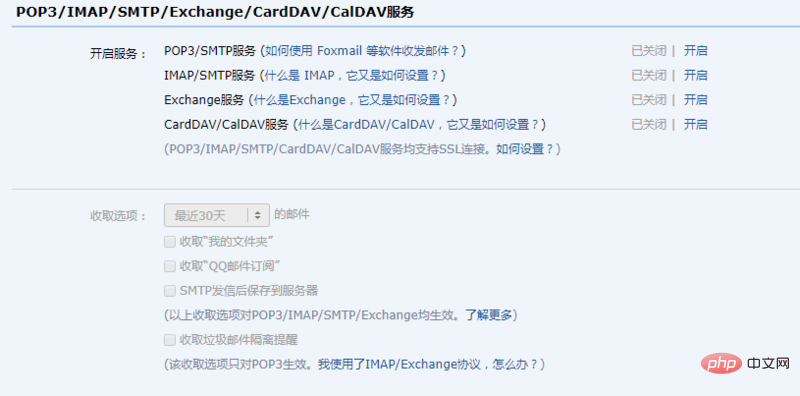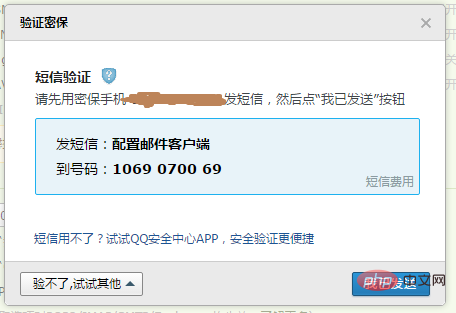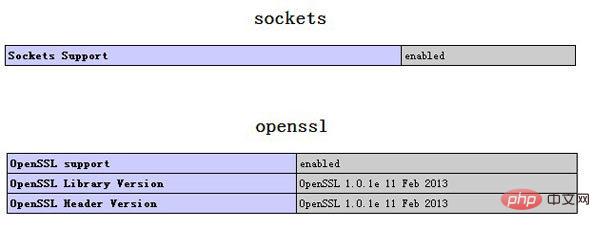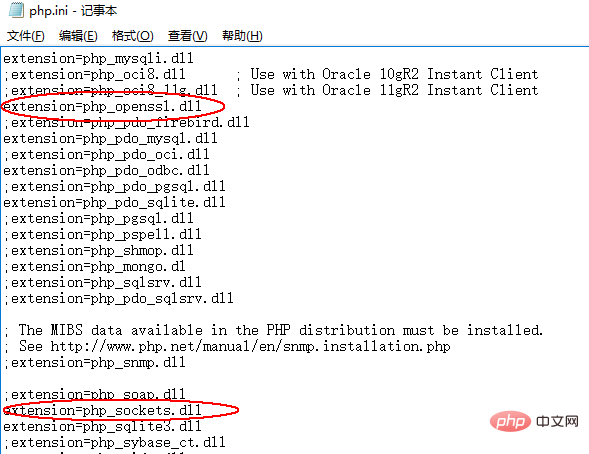

The following takes QQ mailbox as an example to introduce the use of PHP Mailer according to these four aspects:
Introduction to PHP Mailer Step 1: Enable QQ mailbox to send emails Step 2 : Enable PHP to use QQ mailbox to send emails Step 3: Write the code to send emails ThinkPHP uses PHPMailer to send emails
Introduction to PHPMailer
Can run on any platform; Support SMTP verification; specify multiple recipients, CC address, BCC address and reply address when sending mail; Note: Adding CC and BCC is only supported by SMTP mode under the win platform; supports multiple email encodings including: 8bit, base64, binary and quoted-printable; custom email header information, which is similar to sending header information through the header function in PHP. Supports making the email body into HTMl content, then you can insert pictures into the email body; tested and compatible SMTP server Including: Sendmail, qmail, Postfix, Imail, Exchange, etc.
Step 1: Enable QQ mailbox to send mail
Our mailbox can originally send mail, but we need to realize sending it on our website Email, then we need to set up our QQ mailbox, because our website now exists as a third-party client, so we need to use an SMTP server to send it. It is recommended to turn on the first two items here. Got it!
Enter QQ mailbox->Click Settings->Click Account

When you click to open, it will prompt:

After you complete the above steps, you will get an authorization code. You can copy it first and we will use it later (if you enable both items, you will get two authorization codes. Be sure to Newest!).
Step 2: Enable PHP to use QQ mailbox to send emails
PHPMailer requires PHP's socket extension support, and PHPMailer links to the qq domain name mailbox It requires SSL encryption and PHP openssl extension support. You can use phpinfo to check whether the extension is enabled.

If it is not enabled, go to the PHP installation directory and find php.ini to enable two extensions.

Step 3: Write the code to send the email
index.htmlCode As follows:
Encapsulates a public method (written in the functions.php file):
/**
*发送邮件方法
*@param $to:接收者 $title:标题 $content:邮件内容
*@return bool true:发送成功 false:发送失败
*/
function sendMail($to,$title,$content){
require_once("phpmailer/class.phpmailer.php");
require_once("phpmailer/class.smtp.php");
//实例化PHPMailer核心类
$mail = new PHPMailer();
//使用smtp鉴权方式发送邮件
$mail->isSMTP();
//smtp需要鉴权 这个必须是true
$mail->SMTPAuth=true;
//链接qq域名邮箱的服务器地址
$mail->Host = 'smtp.qq.com';
//设置使用ssl加密方式登录鉴权
$mail->SMTPSecure = 'ssl';
//设置ssl连接smtp服务器的远程服务器端口号,以前的默认是25,但是现在新的好像已经不可用了 可选465或587
$mail->Port = 465;
//设置发件人的主机域 可有可无 默认为localhost 内容任意,建议使用你的域名
$mail->Hostname = 'http://www.lsgogroup.com';
//设置发送的邮件的编码 可选GB2312 我喜欢utf-8 据说utf8在某些客户端收信下会乱码
$mail->CharSet = 'UTF-8';
//设置发件人姓名(昵称) 任意内容,显示在收件人邮件的发件人邮箱地址前的发件人姓名
$mail->FromName = '发件人姓名(昵称)';
//smtp登录的账号 这里填入字符串格式的qq号即可
$mail->Username ='[email protected]';
//smtp登录的密码 使用生成的授权码(就刚才保存的最新的授权码)
$mail->Password = '最新的授权码';
//设置发件人邮箱地址 这里填入上述提到的“发件人邮箱”
$mail->From = '[email protected]';
//邮件正文是否为html编码 注意此处是一个方法 不再是属性 true或false
$mail->isHTML(true);
//设置收件人邮箱地址 该方法有两个参数 第一个参数为收件人邮箱地址 第二参数为给该地址设置的昵称 不同的邮箱系统会自动进行处理变动 这里第二个参数的意义不大
$mail->addAddress($to,'尊敬的客户');
//添加多个收件人 则多次调用方法即可
// $mail->addAddress('[email protected]','尊敬的客户');
//添加该邮件的主题
$mail->Subject = $title;
//添加邮件正文 上方将isHTML设置成了true,则可以是完整的html字符串
$mail->Body = $content;
$status = $mail->send();
//判断与提示信息
if($status) {
return true;
}else{
return false;
}
}index.phpThe code is as follows:
If you are using QQ enterprise mailbox, the server address linking to the qq domain name mailbox and the password for smtp login are different:
//链接qq域名邮箱的服务器地址 $mail->Host = 'smtp.exmail.qq.com'; //smtp登录的密码 (QQ企业邮箱的登录密码) $mail->Password = '登录密码';
ThinkPHP uses PHPMailer to send emails
PHPMailer decompresses to ThinkPHPLibraryVendor
Create a new function.php in the Common folder
/**
* 邮件发送函数
* @param $to:接收者 $title:标题 $content:邮件内容
* @return bool true:发送成功 false:发送失败
*/
function sendMail($to, $title, $content) {
Vendor('PHPMailer.PHPMailerAutoload');
Vendor('PHPMailer.class.smtp');
$mail = new PHPMailer(); //实例化
$mail->IsSMTP(); // 启用SMTP
$mail->Host=C('MAIL_HOST'); //smtp服务器的名称
$mail->SMTPSecure = C('MAIL_SECURE');
$mail->Port = C('MAIL_PORT');
$mail->SMTPAuth = C('MAIL_SMTPAUTH'); //启用smtp认证
$mail->Username = C('MAIL_USERNAME'); //你的邮箱名
$mail->Password = C('MAIL_PASSWORD') ; //邮箱密码
$mail->From = C('MAIL_FROM'); //发件人地址(也就是你的邮箱地址)
$mail->FromName = C('MAIL_FROMNAME'); //发件人姓名
$mail->AddAddress($to,"尊敬的客户");
$mail->WordWrap = 50; //设置每行字符长度
$mail->IsHTML(C('MAIL_ISHTML')); // 是否HTML格式邮件
$mail->CharSet=C('MAIL_CHARSET'); //设置邮件编码
$mail->Subject =$title; //邮件主题
$mail->Body = $content; //邮件内容
$mail->AltBody = "您好"; //邮件正文不支持HTML的备用显示
return($mail->Send());
}Add the configuration fileconfig.php
// 配置邮件发送服务器 'MAIL_HOST' =>'smtp.qq.com',//smtp服务器的名称 'MAIL_SMTPAUTH' =>true, //启用smtp认证 'MAIL_USERNAME' =>'[email protected]',//你的邮箱名 'MAIL_FROM' =>'[email protected]',//发件人地址 'MAIL_FROMNAME'=>'[email protected]',//发件人姓名 'MAIL_PASSWORD' =>'xxxxxx,//邮箱密码 'MAIL_CHARSET' =>'utf-8',//设置邮件编码 'MAIL_ISHTML' =>TRUE, // 是否HTML格式邮件 'MAIL_PORT' =>'465',//设置ssl连接smtp服务器的远程服务器端口号 'MAIL_SECURE' =>'ssl',//设置使用ssl加密方式登录鉴权
Finally, use PHPMailer to send the email
public function add(){
if(sendMail($_POST['mail'],$_POST['title'],$_POST['content']))
echo "发送成功";
else
echo "发送失败";
}Related learning recommendations: PHP programming from entry to proficiency
The above is the detailed content of Analyze how PHPMailer sends emails in PHP. For more information, please follow other related articles on the PHP Chinese website!